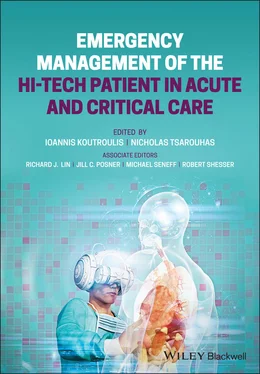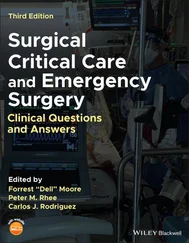1 Cover
2 Title Page
3 Copyright Page
4 List of Contributors
5 Preface
6 Acknowledgments
7 Section I: Gastro‐intestinal Devices 1 Using and Troubleshooting Enteral Feeding Devices Introduction Equipment/Device Basic G‐tube Anatomy Indications Management Complications/Emergencies Colocutaneous Fistula Consultation Further Reading 2 Gastrointestinal Diversions Introduction Equipment/Device Indications Management Complications/Emergencies Consultation Further Reading 3 Management of the Bariatric Surgery Patient in the Emergency Department Introduction Surgical Procedures Indications Complications Further Reading 4 Transjugular Intrahepatic Portosystemic Shunt Introduction Equipment/Device Indications Contraindications Management Complications Consultation Further Reading
8 Section II: Central Catheters 5 Indwelling Central Venous Catheter Devices Introduction Central Venous Catheter Types Catheter Anatomy Routine Management and Use Accessing and Drawing Blood from an Externalized CVC (Broviac, Hickman, PICC) Accessing and Drawing Blood from a Fully Implanted Catheter (“Port”) Complications Infection Catheter Breakage and Dislodgement Catheter Occlusion Air Embolism and Other Rare Complications Further Reading 6 Vascular Access for Hemodialysis Introduction Equipment/Device Indications Management Complications/Emergencies Consultation Further Reading 7 Peritoneal Dialysis Catheters Introduction Equipment Device Indications Management Complications Further Reading
9 Section III: ENT and OMFS Devices 8 Orthopedic Devices IntroductionIndications Complications, Emergencies, and Their Management Equipment/Devices Complications, Emergencies, and their Management Equipment/Devices Complications, Emergencies, and Their Management Equipment/Devices Complications, Emergencies, and Their Management Complications, Emergencies, and Their Management Equipment/Devices Complications, Emergencies, and Their Management Further Reading 9 Spine Devices Introduction Devices Indications Management Complications Consultation Summary Further Reading 10 Facial Distractors Introduction Equipment/Device Indications Management Complications/Emergencies Consultation Further Reading 11 Management of Facial Fractures in Adults and Children Introduction Anatomy Evaluation Indications and Equipment/Devices Complications Conclusions Further Reading 12 Cranial Orthotics and Ear Molding Introduction Indications Ear Molding Further Reading 13 Ear, Nose, and Throat Devices Introduction Ear Devices Myringotomy Tubes Conventional Hearing Aids Cochlear Implants Bone‐Anchored Hearing Aids (BAHA) Auricular Prosthesis Nasal Devices Septal Buttons Sinus Stents Nasolacrimal Duct Stents Throat Further Reading
10 Section IV: CNS Devices 14 Cerebral‐ventricular Shunts Introduction Indications Complications/Emergencies Consultations and Management Head Imaging Shunt Radiographic Series Abdominal Ultrasound Further Reading 15 Initial Evaluation and Management of Patients with Neurosurgical Devices Introduction Neuromodulatory Devices Intrathecal Infusion Pumps Further Reading
11 Section V: Miscellaneous Devices 16 Ophthalmic Devices Introduction Eyelid Nasolacrimal Duct (NLD) Orbit Eye 17 Breast Implants Introduction Devices Indications Management Complications/Emergencies Exposure/Dehiscence Hematoma Skin Necrosis Rotation/Malposition Capsular Contracture Mondor's Disease Consultation Further Reading 18 Cutaneous Delivery Systems/Patches Introduction Indications Management Complications/Emergencies Further Reading 19 Dental Emergencies Involving Oral Hardware Introduction Dental Braces Dental Implants Dental Crowns and Bridges Dental Fillings Further Reading
12 Section VI: Wound Management Devices 20 Emergency Management of Patients with Negative Pressure Wound Therapy Devices (NPWTD) Introduction Mechanisms of Action Equipment/Device Clinical Use Indications and Contraindications Morbidity and Mortality Approach to the ED Patient with an NPWTD Further Reading 21 Emergency Management of Patients with Wound Infections General Considerations Further Reading
13 Section VII: GU Devices 22 Emergency Management of Patients with Genitourinary Prostheses Introduction Artificial Urinary Sphincter Penile Prostheses InterStim Physical Exam Findings in Patients with Genitourinary Implants Management of Genitourinary Prosthesis Complications Further Reading
14 Section VIII: Cardiac Devices 23 Management of Prosthetic Valve Complications Introduction Equipment/Device Indications Management Complications/Emergencies Consultation Further Reading 24 Emergency Management of Patients with Vascular Occlusion Devices, Stents, or Filters Introduction Congenital Heart Defect Management and Occlusion Devices Atrial Septal Defect Occlusion Devices Ventricular Septal Defect (VSD) Occlusion Devices Patent Ductus Arteriosus (PDA) Occlusion Devices Arterial Stents Coarctation of the Aorta Stenting Inferior Vena Cava (IVC) Filters Left Atrial Appendage Devices Further Reading 25 The Emergency Department Approach to the Patient with an Implantable Mechanical Circulatory Support Device Further Reading 26 Emergency Management of the Patient with an Implantable Pacemaker or Defibrillator Introduction The Structure and Functions of Implanted Cardiac Devices (ICD’s) Indications for Placement of Pacemakers and Defibrillators Routine Management of Implanted Cardiac Devices Complications and Emergencies of Patients with Implanted Cardiac Devices Consultation Further Reading
15 Section IX: Pulmonary Devices 27 Invasive Ventilation Introduction Background Components of the Patient Ventilator System and Their Uses Case Vignette Troubleshooting Conclusion Further Reading 28 Respiratory Medication Devices Introduction Equipment/Device and Interface Options Inhalers Accessory Devices Interface Management Device Selection Complications/Emergencies Infection Risks and Maintenance Further Reading 29 Secretion Clearance Devices Cough Augmentation Intermittent Positive Pressure Breathing Peripheral Mucus Mobilization Handheld Devices Pharmacotherapy Further Reading 30 Non‐invasive Ventilation Components of Non‐Invasive Ventilation Further Reading 31 Tracheostomy Tubes Introduction Tracheostomy Tube Basics Shiley Tracheostomy Tubes Tracoe Tracheostomy Tubes Bivona and Portex Tracheostomy Tubes by Smiths‐Medical Tracheostomy Cuffs Evaluation of Tracheostomy Tube Positioning Routine Tracheostomy Care Tracheostomy Tube Suctioning Tracheostomy Emergencies Further Reading
16 Index
17 End User License Agreement
1 Chapter 1 Table 1.1 Enteric feeding devices. Table 1.2 Enteric feeding device contraindications. Table 1.3 NG tube insertion. Table 1.4 Gastrostomy‐tube replacement.
2 Chapter 3 Table 3.1 GI symptoms and associated causes. Table 3.2 Bariatric surgery complications.
3 Chapter 5 Table 5.1 Procedure for accessing an externalized central venous catheter. Table 5.2 Procedure for accessing an implanted central venous catheter.
4 Chapter 8Table 8.1 Modified Wells' criteria for risk stratification for DVT.
5 Chapter 11Table 11.1 Commonly encounteredcraniomaxillofacial (CMF) fractures with assoc...
6 Chapter 12Table 12.1 Common clinical findings of single suture synostosis.
7 Chapter 14Table 14.1 Common presentation of shunt problems by age group.
8 Chapter 26Table 26.1 The North American society for pacing and electrophysiology/Britis...
9 Chapter 28Table 28.1 Medications via aerosol for acutely Ill patients.
10 Chapter 29Table 29.1 Pathophysiologies in secretion clearance and methods, devices, and...
11 Chapter 31Table 31.1 Examples of indications for a tracheostomy.Table 31.2 Airway‐related questions for the clinician to ask.Table 31.3 Initial physical assessment pertaining to tracheostomy.Table 31.4 Recommendations for tracheostomy size based on age and weight.Table 31.5 Single cannula trach tubes.Table 31.6 Double cannula trach tubes.
Читать дальше












